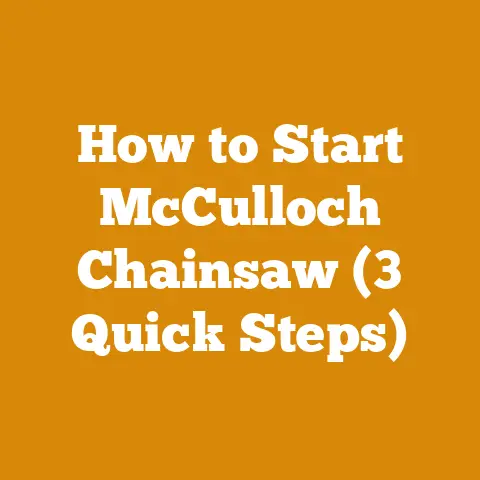how to replace the chain on a ryobi chainsaw (Quick Steps)
You and I are going to explore the ins and outs of replacing the chain on your trusty Ryobi chainsaw. Imagine us in a cozy garage or workshop, surrounded by tools, ready to tackle this task together. Whether it’s your first time or you’re just looking for some extra tips, I’ve got your back.
Our Journey Begins: Setting the Stage
Why Replace the Chain?
Chainsaw chains wear out over time due to constant use. They become dull, which can lead to inefficient cutting and even dangerous kickbacks. A fresh chain not only improves performance but also ensures safer operation.
My First Experience
Let me share a little story. The first time I replaced a chain, I was nervous. I had visions of chains flying off and tools scattered everywhere. But with patience and the right guidance, I managed just fine. That’s the experience I want for you—confidence and success.
Prerequisites: What You Need to Know
Before we dive into the nitty-gritty details, let’s cover some basics. Understanding these will make the process smoother.
Basic Understanding
- Familiarity with Parts: Knowing the main components of your chainsaw—such as the bar, sprocket, and chain tensioner—will help immensely.
- Safety Protocols: Always prioritize safety. Chainsaws are powerful tools and should be handled with care.
Required Materials
Gathering your tools and materials beforehand is like preparing for a road trip. Here’s what you’ll need:
- New Ryobi Chainsaw Chain: Double-check the size compatibility with your model.
- Chainsaw Wrench or Socket Wrench: This will be your best friend during disassembly.
- Screwdriver: Handy for any additional adjustments.
- Protective Gloves and Safety Goggles: Never skimp on safety gear.
- Cleaning Brush or Cloth: To tidy up internal parts before reassembly.
Safety First: Protecting Yourself and Your Tools
Let’s talk safety. I can’t stress enough how important it is to protect yourself when working with chainsaws.
Critical Safety Tips
- Disconnect Power: Ensure the chainsaw is turned off and remove the spark plug before starting. This prevents accidental starts.
- Wear Protective Gear: Always use gloves to protect your hands from sharp chain edges, and goggles to shield your eyes from debris.
- Work on a Stable Surface: This reduces the risk of accidents and ensures precision during the replacement process.
The Step-by-Step Guide to Replacing Your Chainsaw Chain
Alright, with our safety gear on and tools ready, let’s dive into replacing that chain. I promise to make it as painless as possible!
Step 1: Preparing Your Workspace
Creating an Efficient Space
Find a flat, stable surface in a well-lit area. Lay out all your tools and materials so everything’s within reach. This might sound basic, but trust me—having an organized workspace makes a world of difference.
Step 2: Removing the Chainsaw Cover
- Locate the Nuts: Using your chainsaw wrench, carefully loosen and remove the nuts holding the side cover in place.
- Remove the Cover: Slide off the cover gently to expose the chain and bar. It’s kind of like opening a treasure chest, revealing all those inner workings.
Step 3: Releasing the Tension
- Loosen the Chain: Turn the tensioning screw counterclockwise to release tension on the chain.
- Remove the Chain: Carefully slide the old chain off the guide bar. This is where those gloves really come in handy.
Step 4: Inspecting and Cleaning
Before we put on that shiny new chain, let’s do some housekeeping.
- Inspect the Guide Bar: Look for any signs of wear or damage. A worn-out bar can affect cutting efficiency.
- Clean Out Debris: Use a brush or cloth to clean any sawdust or grime from the sprocket area. It’s like giving your chainsaw a spa day!
Step 5: Installing the New Chain
- Positioning the New Chain: Place it onto the guide bar, ensuring the cutting teeth face forward on top of the bar. Remember, orientation matters!
- Aligning with Sprocket: Fit the chain around the sprocket at the rear. This step can be a bit tricky—take your time to get it right.
Step 6: Tightening Up
- Replace the Side Cover: Position it back over the bar and chain.
- Secure with Nuts: Hand-tighten the nuts initially to hold everything in place.
- Adjust Tension: Use your wrench to turn the tensioning screw clockwise until there’s about a quarter-inch of slack when you pull up on the chain.
Step 7: Final Check and Test
- Tighten Completely: Now that everything’s aligned, fully tighten those nuts with your wrench.
- Test Tension: Pull up on the chain; it should snap back into place without sagging or being too tight.
Additional Insights and Pro Tips
Let me share some nuggets of wisdom from my years of working with chainsaws.
Pro Tips
- Correct Chain Direction: Always double-check that the chain teeth face forward on top of the bar. A backward chain won’t cut and can damage your saw.
- Regular Maintenance: Clean your chainsaw after each use to prolong its life and ensure peak performance.
Troubleshooting Common Issues
Even with meticulous care, things don’t always go as planned. Here’s how to handle some common hiccups.
Common Problems
- Chain Keeps Coming Loose?
- Make sure you’ve tightened both the tensioning screw and nuts adequately. If it persists, inspect for wear in tensioning components.
- Chain Won’t Fit?
- Double-check that you have the correct replacement chain size as per your chainsaw’s manual specifications.
- Chain Is Too Tight or Too Loose?
- Revisit Step 6 for adjusting tension correctly. A properly tensioned chain is crucial for safe operation.
Historical Context & Evolution
Chainsaws have come a long way! Originally developed in the late 1920s for logging purposes, they’ve evolved into versatile tools used in various fields today—from forestry to ice sculpting! Ryobi has been at the forefront of innovation, making user-friendly models accessible to hobbyists and professionals alike.
Wrapping It Up
Replacing a chainsaw chain is more than just a task; it’s part of maintaining a tool that serves as an extension of yourself in your work or hobbies. With practice, this process becomes second nature, almost meditative—just you and your chainsaw in harmony.
FAQs
Let’s wrap up with some frequently asked questions that might still be lingering in your mind.
How often should I replace my chainsaw chain?
Typically when it becomes dull or damaged. Regular maintenance might extend its life, but eventually, all chains need replacing after several sharpenings.
Can I use any brand of chain on my Ryobi chainsaw?
While there are many brands available, it’s best to use Ryobi-compatible chains for optimal performance and safety.
What if my chainsaw doesn’t start after replacing the chain?
Check if all components are reassembled correctly and ensure that the spark plug is connected properly.






